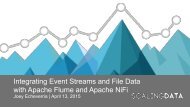NCDS-Summit-2013
NCDS-Summit-2013
NCDS-Summit-2013
Create successful ePaper yourself
Turn your PDF publications into a flip-book with our unique Google optimized e-Paper software.
place regarding covert DNA collection; the remaining states<br />
have only context-specific statutes.<br />
The Fourth Amendment of the U.S. Constitution:<br />
“The right of the people to be secure in their persons,<br />
houses, papers, and effects, against unreasonable<br />
searches and seizures, shall not be violated, and<br />
no warrants shall issue, but upon probable cause,<br />
supported by oath or affirmation, and particularly<br />
describing the place to be searched, and the persons<br />
or things to be seized.”<br />
Distinctions also need to be made between privacy versus<br />
confidentiality versus security. These terms carry very different<br />
meanings in the context of the law than they do in<br />
the context of technology, research, and medicine. Very few<br />
legal protections surround an individual’s rights to privacy<br />
or security as they relate to genomic information. HIPAA<br />
Privacy Rule protections and regulatory requirements apply<br />
to genomic data that is acquired as a result of health care<br />
services, but they do not apply to genomic data arising in<br />
other contexts, such as participation in research outside of<br />
Key Recommendations for Genomics<br />
After discussion of the many challenges inherent<br />
in genomics, the Leadership <strong>Summit</strong> participants<br />
focused on a few critical challenges and reached<br />
consensus on the key recommendations to address<br />
those challenges and thereby move the field forward.<br />
Specifically, the Consortium recommends the actions listed<br />
below.<br />
Recommendations to foster interdisciplinary collaboration<br />
and coordination of efforts in genomics<br />
• Efforts to create a “Consortium of Consortia” need to<br />
be fostered to centralize the efforts and resources of<br />
competing or parallel groups and thereby eliminate<br />
redundancies and more quickly move the field forward<br />
(e.g. Worlwide Genome Web [Maltbie, <strong>2013</strong>]).<br />
• The activities of individual groups in the development<br />
of standards for variants and phenotypes<br />
(e.g., ClinVar, PhenX, EMERGE, CRVR)<br />
must be coordinated to allow for crowdsourcing,<br />
industry involvement, and international input.<br />
• Greater collaboration is required among data scientists,<br />
information technologists, genomic researchers, and<br />
geneticists to further efforts at software development<br />
(e.g., hackathons) for research and clinical applications.<br />
Recommendations to advance analytical approaches and<br />
tools for widespread adoption of standards and federated<br />
distributed data systems, harmonization of existing data<br />
clinical settings or from direct-to-consumer genomic testing.<br />
HIPAA also permits the sharing of genomic data under<br />
the same terms that it permits the sharing of ‘conventional’’<br />
health care records, including its use for research (US<br />
DHHS, http://www.hhs.gov/ocr/privacy).<br />
Society as a whole has not had an active discussion on why<br />
it is problematic to make genomic sequences public information.<br />
In other realms of society, there is very little privacy<br />
or confidentiality, and it is acceptable to share personal<br />
information. For example, photos are routinely posted on<br />
Facebook; personal location is commonly broadcast using<br />
Waze; and thoughts are publicly shared via Twitter. Yet society<br />
overwhelmingly regards genomic information as private.<br />
Why genomic information should be treated differently<br />
than other forms of personal information is a question with<br />
many possible answers. Perhaps people view their DNA as<br />
somehow part of their individual. Perhaps they fear misuse<br />
of their genomic data. Misuse of genomic information (e.g.,<br />
denial of health insurance coverage) should be prohibited,<br />
but whether that translates into a general right to privacy<br />
protected under the law is for genomic information is not<br />
clear. These and related bioethical and legal issues have yet<br />
to be fully vetted by stakeholders and society as a whole.<br />
sets, integrated analyses, data repurposing and reuse, and<br />
discovery science<br />
• Phenotypic data elements need to be standardized and<br />
existing phenotype data sets must be harmonized to facilitate<br />
analysis and promote data sharing, repurposing,<br />
and reuse.<br />
• New tools need to be developed to enable integrated<br />
analyses of data on genomic variants and phenotypes;<br />
these tools need to be capable of extracting phenotypic<br />
data elements from existing data sets for use in hypothesis-driven<br />
research and from real-world data sets for<br />
use in discovery science in order to identify new, previously<br />
unrecognized phenotypes patterns in data derived<br />
from genomic data sets and other heterogeneous types<br />
of data sets.<br />
• New or recoded software algorithms and computational<br />
approaches need to be developed to better structure,<br />
manage, and analyze massive data sets and metadata<br />
over time as data are shared, analyzed, applied, and<br />
reused; funding programs such as the joint Big Data<br />
program sponsored by the National Institutes of Health<br />
and the National Science Foundation represent only an<br />
initial step in this direction.<br />
• Federated distributed data systems (e.g., iRODS, Data<br />
Verse) must be adopted across research groups, with<br />
trust fabrics in place to ensure quality of and provenance<br />
over data and to facilitate analysis.<br />
Data to Discovery: Genomes to Health / page 13




